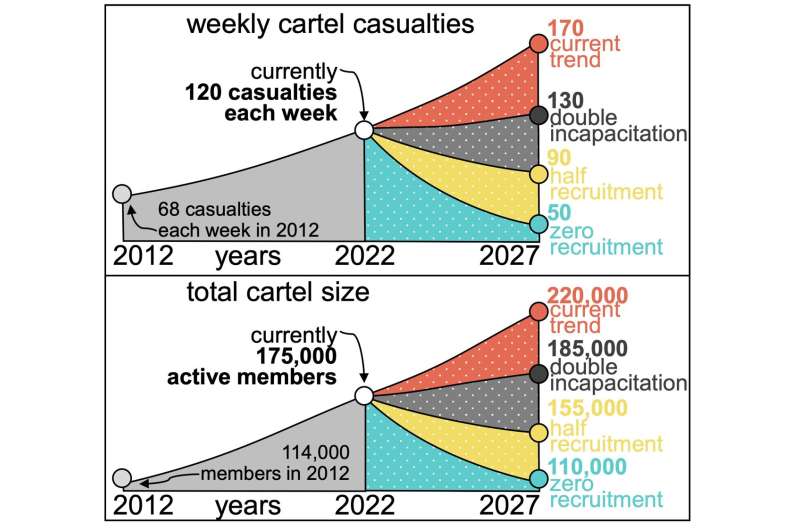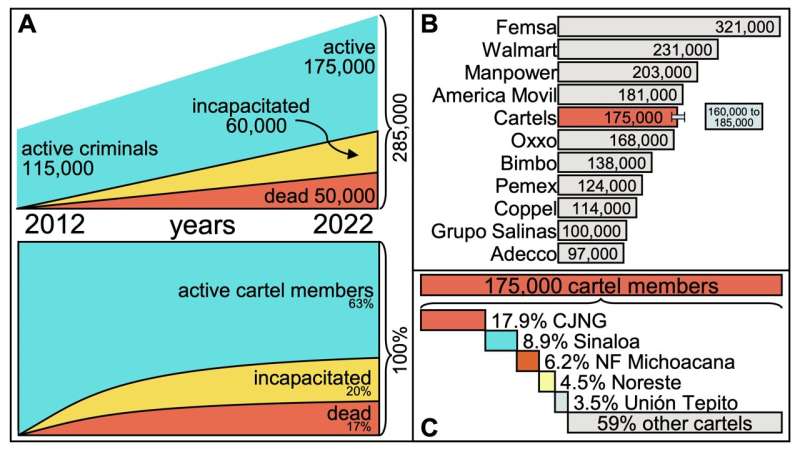This article has been reviewed according to Science X's editorial process and policies. Editors have highlighted the following attributes while ensuring the content's credibility:
fact-checked
peer-reviewed publication
trusted source
proofread
Curbing violence in Mexico: Disrupting cartel recruitment holds the key, new study finds

Not through courts and not through prisons. The only way to reduce violence in Mexico is to cut off recruitment. Increasing incapacitation instead leads to both more homicides and cartel members, researcher Rafael Prieto-Curiel from the Complexity Science Hub and colleagues show in a study published in Science.
In 2021, approximately 34,000 people died from intentional homicides in Mexico—the equivalent of nearly 27 victims per 100,000 population. This ranks Mexico among the least peaceful countries worldwide.
Fifth largest employer
In order to be able to address this violence in the most targeted way possible, researchers now studied the cartels' evolution by using data on murders, missing persons, and incarcerations in Mexico between 2012 and 2022. Therefore, they combined data from the National Institute of Geography and Statistics in Mexico (INEGI) on homicides, the national registry of missing persons (RNPDNO), and data from the Mexican prison census.
Their results show that Mexican cartels currently have between 160,000 and 185,000 members. This makes them the fifth largest employer in the country—with far-reaching effects on the population. And despite the state's efforts to limit the cartels' power by, for example, imprisoning nearly 6,000 cartel members annually, the cartels have increased their membership by 60,000 since 2012.

Recruiting 350 people per week
At the same time, they themselves lose many members to killings. "The career path of cartels is very short and violent. In 10 years, 17% of the people recruited by cartels will be dead, and 20% will be incapacitated in some prison," explains Rafael Prieto-Curiel from the Complexity Science Hub. At least 350 people need to be recruited per week to avoid collapse due to total losses, the researcher says.
Massively increasing violence
Still, violence has not decreased. On the contrary, between 2012 and 2021, cartel-related deaths increased by 77%. "If Mexico continues this path, it will experience 40% more deaths by 2027 than it does today, and the cartels will have 26% more members," Prieto-Curiel says. Even if it were possible to prosecute twice as many cartel members and have twice as many people in prison, there would still be 8% more deaths in 2027.
Cutting off recruitment
In comparison, halving the cartel's ability to recruit would reduce weekly casualties by 25% and the cartel's size by 11% until 2027.
"Mathematically, therefore, a preventive strategy is significantly more successful than a traditional reactive strategy," Prieto-Curiel says. However, the cartels are so large that even if recruitment were to drop to zero, it would take three years to return to the already high levels of violence seen in 2012. That's why swift and comprehensive action is needed.
First scientific attempt
Despite the Mexican cartels' economic, social, and political importance, essential information about their size and the impact of various policies designed to limit their power has been lacking.
"To the best of our knowledge, this work provides the first scientific attempt to mathematically quantify the size of cartels in Mexico and compare policy strategies to reduce violence in the country. We, therefore, hope to make an important contribution to a more peaceful future of Mexico," Prieto-Curiel says.
More information: Rafael Prieto-Curiel, Reducing cartel recruitment is the only way to lower violence in Mexico, Science (2023). DOI: 10.1126/science.adh2888. www.science.org/doi/10.1126/science.adh2888
Journal information: Science
Provided by Complexity Science Hub Vienna



















